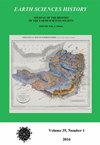英国军事对马耳他地质的贡献,第2部分:第二次世界大战,1939-1945
IF 0.3
4区 哲学
Q4 GEOSCIENCES, MULTIDISCIPLINARY
引用次数: 0
摘要
在第二次世界大战期间,地中海中部的马耳他岛被意大利海军包围,并被意大利和后来的德国空军密集轰炸,从1940年6月到1943年5月盟军在北非的胜利结束了围困。1943年7月,它被计划作为一个中转站,支持盟军从北非入侵西西里,并于9月从西西里入侵意大利本土。从1941年到1945年,两个隧道公司的皇家工程师,相继重叠,挖掘地下设施免受空中或海上轰炸。1943年和1944年至1945年,两个钻孔工兵组连续打井以增加供水,最初是为了增加部队的集中。1943年,英国地质调查局局长(Edward Battersby Bailey: 1881-1965)、地质学家Frederick William Shotton上尉(1906-1990)和Gordon Lyall Paver少校(1913-1988)指导了钻孔地点的选择。1944年,地质学家霍华德·迪格比·罗伯茨(Howard Digby Roberts, 1913-1971)上尉带领南非工程兵团第42地质部的一个分队,率先在该岛进行地球电阻率调查。总的来说,这些军事研究产生了一个新的但未发表的岛屿地质图,比例为1:31 680,并完善了其地质结构的知识:一个断层较多但其他方面接近水平的渐新世至中新世沉积序列。1944年至1945年,由英国皇家工程师的地质学家Thomas Owen Morris上尉(1904-1989)领导的钻井计划进一步完善了该技术。到1945年,这有助于为该岛开发改进的供水系统,并计划开发从上层含水层(在上层珊瑚灰岩和下层绿土地层中,位于“蓝色粘土”之上)以及靠近海平面的主要下层含水层(在Globigerina石灰石和/或下层珊瑚灰岩地层中)提取的地下水。本文章由计算机程序翻译,如有差异,请以英文原文为准。
BRITISH MILITARY CONTRIBUTIONS TO THE GEOLOGY OF MALTA, PART 2: THE SECOND WORLD WAR, 1939–1945
During the Second World War, the central Mediterranean island of Malta was famously besieged by the Italian navy and intensively bombed by Italian and later German air forces, from June 1940 until Allied victory in North Africa in May 1943 brought an end to the siege. It was then scheduled as a staging post to support the Allied invasion of Sicily from North Africa in July 1943 and of mainland Italy from Sicily in September. From 1941 until 1945, two Tunnelling Companies Royal Engineers, overlapping in succession, excavated underground facilities safe from aerial or naval bombardment. In 1943 and then 1944–1945, two Boring Sections Royal Engineers in succession drilled wells to enhance water supplies, initially for increased troop concentrations. Borehole site selection was guided in 1943 by the Director of the Geological Survey of Great Britain (Edward Battersby Bailey: 1881–1965) and by geologists Captain Frederick William Shotton (1906–1990) and Major Gordon Lyall Paver (1913–1988). In 1944, it was guided by geologist Captain Howard Digby Roberts (1913–1971), leading a detachment from 42nd Geological Section of the South African Engineer Corps that pioneered earth resistivity surveys on the island. Overall, these military studies generated a new but unpublished geological map of the island at 1:31,680-scale and refined knowledge of its geological structure: a much faulted but otherwise near-horizontal Oligo-Miocene sedimentary sequence. Further refinement was achieved as a consequence of the 1944–1945 drilling programme, led principally by geologist Captain Thomas Owen Morris (1904–1989) of the Royal Engineers. By 1945, this had helped to develop an improved water supply system for the island, and plans to develop groundwater abstracted from a perched upper aquifer (in the Upper Coralline Limestone and underlying Greensand formations, above a ‘Blue Clay’) as well as from the main lower aquifer, near sea level (in the Globigerina Limestone and/or underlying Lower Coralline Limestone formations).
求助全文
通过发布文献求助,成功后即可免费获取论文全文。
去求助
来源期刊

Earth Sciences History
GEOSCIENCES, MULTIDISCIPLINARY-HISTORY & PHILOSOPHY OF SCIENCE
CiteScore
1.00
自引率
0.00%
发文量
1
审稿时长
>12 weeks
期刊介绍:
Earth Sciences History promotes and publishes historical work on all areas of the earth sciences – including geology, geography, geophysics, oceanography, paleontology, meteorology, and climatology.
The journal honors and encourages a variety of approaches to historical study: biography, history of ideas, social history, and histories of institutions, organizations, and techniques.
Articles are peer reviewed.
 求助内容:
求助内容: 应助结果提醒方式:
应助结果提醒方式:


